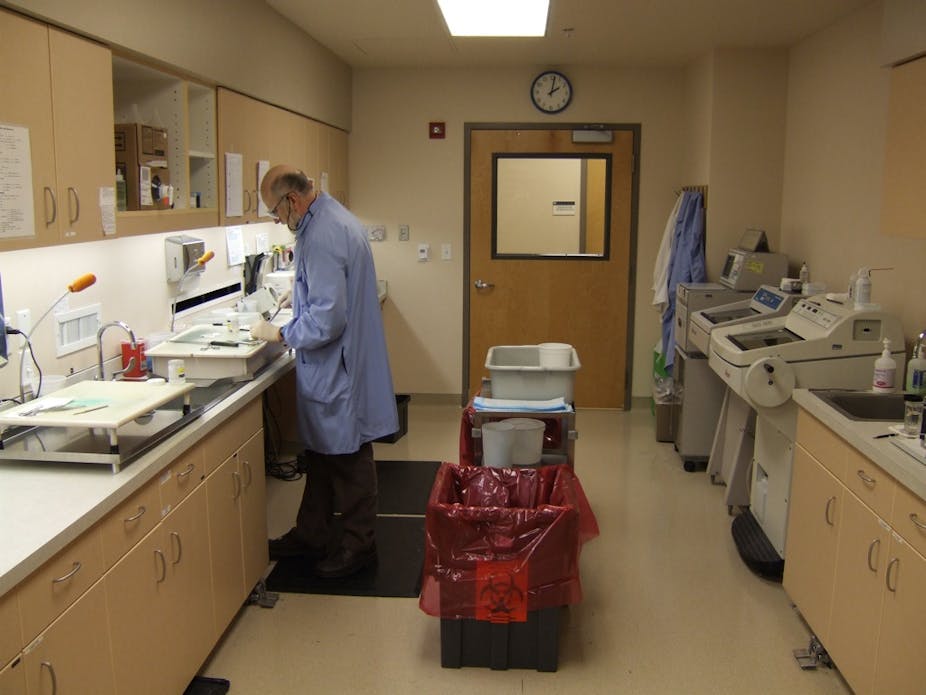The Australian Government is looking – very quietly – at pathology payola.
Pathology services in Australia are big business, reflecting the shift from the days when your kindly family physician – the one who did house-calls in midwinter without complaint and omitted to charge the poor – placed a blood sample on a slide, peered into his microscope and invariably come up with the right diagnosis. In 2012 Dr Finlay and Dr Kildare are long gone.
Pathology is now a matter of multi-million dollar laboratories relying on economies of scale and drawing on samples provided by medical practices across a region or even a state.
Those practices may be large, for example involving 20 or more specialists and general practitioners, and may form part of multi-practice groups, which is what you’d expect in an era of increasingly corporatised medicine. They typically aren’t controlled by the pathology services.
Some of those services are overtly commercial, driven by “medical entrepreneurs” and private equity. Others generate substantial revenue but are badged as religious organisations and perceived as non-commercial.
The services rely on medical practices providing them with blood, tissue and other samples for testing. (Consumers typically can’t go direct to a testing service or specify that a medical practice sends that patient’s sample to a service of the consumer’s choice.)
The services compete in an oligopolistic market, seeking to persuade practices to supply samples on an ongoing and frequent basis, consistent with economies of sale. Practices typically affiliate with a specific service; a decision to switch from one service provider can result in job losses and lower share prices for listed providers. Persuasion is not necessarily because a particular service provider delivers more accurate results on a faster basis. (Rigorous technical accreditation means there’s consistency in service delivery.)
Affiliation instead reflects service providers offering incentives to the practices. Those incentives centre on leasing space within the practices. That space often consists of a square metre of carpet or reception counter. The payment for the space is, however, significant. In some practices it’s equivalent to leasing prime Tokyo real estate during the 1980s Japanese property bubble. Leasing costs are of course passed on to individual consumers and the taxpayer, given that pathology services are ultimately funded by public/private health insurance schemes and patients rather than by general practitioners and specialists.
Leasing for what the industry characterises as “collection centres” is a nice earner for the medical practices. Paying for collection centres is a cost of operating a major pathology service. In the absence of a prohibition by the Government the providers understandably keep paying the payola to the medical practices. Canberra is aware of the leasing payments through reporting by the pathology services but hasn’t acted.
The national government shapes the pathology market by recognition of particular tests, standards and rules for the overall market. The service providers thus need to grapple with expectations about a commercial return on capital, the Australian Pathology Funding Agreement (PFA) and demands by practices for payment.
In 2010 the Government deregulated the number of collection centres that could be operated by any pathology service. The expectation was that deregulation would lead to greater competition and thus greater efficiency. Critics however forecast that costs would rise, with practitioners cashing in on a “collection centre land grab” or “gold rush” and the larger service providers reinforcing market dominance at the expense of smaller competitors.
Those fears appear to have been justified, with at least one entrant in Victoria (Pathology Services Pty Ltd) being bought out by an industry major. Deutsche Bank estimated margins fell by 20% after a 60% increase in the number of collection centres. Good news for practices, bad news for the overall health system.
There has been little publicity about the review, scheduled for completion in April next year. It involves the Treasury, Department of Health & Ageing, Department of Human Services, Department of Finance & Administration and non-government signatories to the PFA.
Commencement of the review has been marked by warnings from pathology service leaders such as Ed Bateman against further regulation. That’s presumably because re-regulation, as with any regulation, is perceived as bad in principle. It’s probably also because the leading businesses can cope with lower margins and are averse to the uncertainty or disruption associated with any change.
From a public policy perspective what’s disappointing about the review is the lack of information about what’s going on, reinforcing fears about regulatory capture. Australia’s ageing population means health costs will inevitably rise. The review is a lost opportunity for politicians, officials and industry figures to articulate how the health system works and why particular decisions are being made.
If nothing else, optimism about deregulation appears to have been misplaced. We should be asking hard questions about the performance of the people who authorised the land grab. They’re the same people who’ll be making other fundamental decisions about services in health markets.

